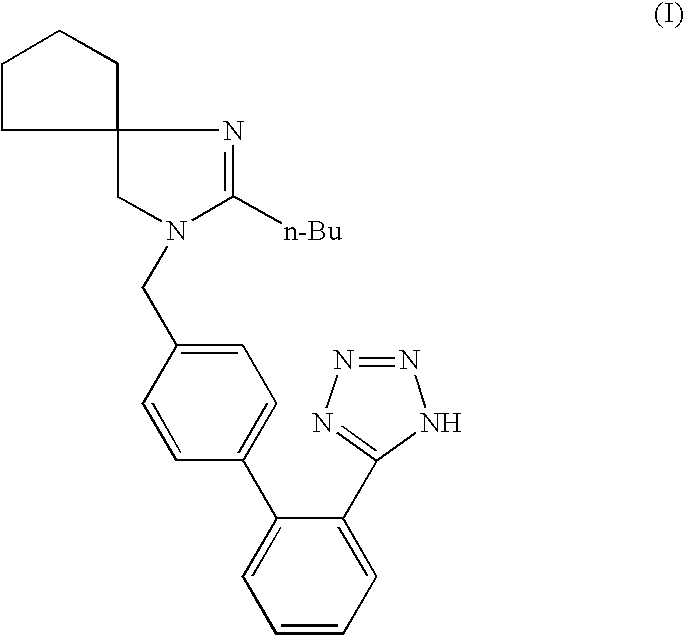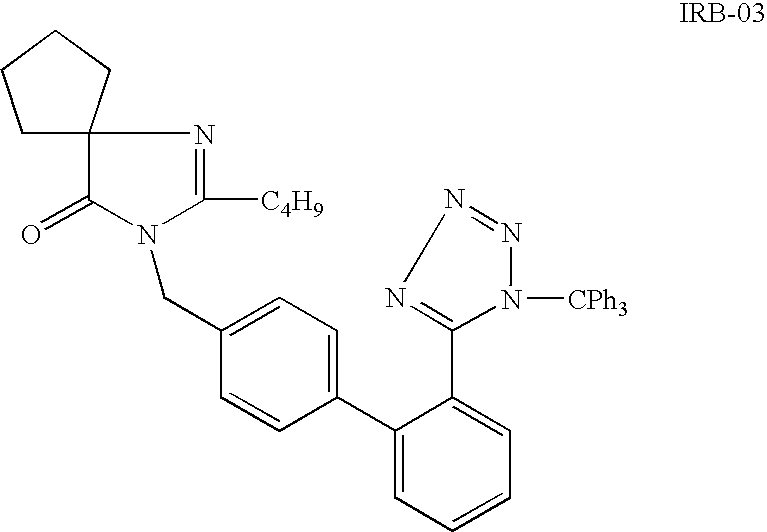Synthesis of irbesartan
a technology of irbesartan and irbesartan, which is applied in the field of synthesis of irbesartan, can solve the problems of difficult removal, high boiling of dipolar aprotic solvents (e.g. methyl pyrrolidone), and the risk of azide us
- Summary
- Abstract
- Description
- Claims
- Application Information
AI Technical Summary
Problems solved by technology
Method used
Image
Examples
example ia
Preparation of IRB-05
[0037]
Weight;MwvolumeMmolEq.IRB-01230.7357.7g2501.254-Bromobenzyl bromide249.4950.0g2001.0Potassium hydroxide, 85%56.1149.6g7503.75Water200mLBu4NHS04339.548.5g0.125Toluene800mL
[0038]To a preheated (90° C.) solution of 4-bromobenzyl bromide and phase transfer catalyst (Bu4NHSO4) in toluene was added a prestirred (40 min at room temperature) solution of KOH and IRB-01 in water. The resulting two-phase mixture was heated for 1 hour at 90° C. with vigorous stirring. The mixture was cooled to room temperature, water (500 mL) was added and the mixture was stirred for additional 30 min. The phases were separated and the aqueous phase was extracted with an additional portion of toluene (100 mL). The combined organic portions were washed with water and brine, dried over Na2SO4 and evaporated under reduced pressure. 74.0 g of IRB-05 was obtained as a colorless oil. The yield was 94%, with a purity of 94%.
example 1b
Preparation of IRB-06
[0039]
Weight;MwvolumeMmolEq.5-Phenyl-1H-tetrazol146.1556.0g3831.0Chlorotriphenylmethane278.78112.0g4021.05Et3N101.261.0ml,4401.15THF400mL
[0040]To a solution of 5-phenyl-1H-tetrazol and triethylamine in dry THF was added, in one portion, chlorotriphenylmethane. The reaction was slightly exothermic, about 40° C. The resulting suspension was stirred under argon for 2 hours (TLC monitoring; Hex / EtOAc 4:1). The mixture was cooled to 0° C., stirred for 30 min and the precipitated triethylammonium chloride was filtered and washed with cold THF (100 mL). The filtrate was evaporated under reduced pressure and the yellow solid residue (approx. 180 g) was crystallized from acetonitrile (800 mL) to give 141.5 g. The yield was 94%, with a purity of 94%.
example 1c
Preparation of 2-(5-(1-trityl-1H-tetrazol)phenylboronic acid (IRB-07)
[0041]
Weight,MwvolumemmolEq.IRB-06388.4639.0g1001.0BuLi (1.6 M in hexane)75.0mL1201.2Triisopropyl borate188.0830.0mL1301.3THF250mL
[0042]The solution of 5-phenyl-1-trityl-1H-tetrazole (IRB-06) in dry THF (Prepared in Example 1B) was cooled to −20° C. under Argon. Traces of water were quenched with n-butyllithium (approx. 5 mL). When the mixture remained red for 5 minutes the addition was stopped. The main charge of n-butyllithium was then added dropwise at temperature below −15° C. and the resulting red suspension was stirred for additional 30 minutes at −20° C. The mixture was cooled to −30° C., and triisopropyl borate was slowly added, with the reaction temperature maintained at below −20° C. At this point, the slurry was dissolved and the resulting red solution was stirred for 30 minutes at −25° C., and then warmed to room temperature over 40 minutes. The solvents were evaporated under reduced pressure and the ye...
PUM
| Property | Measurement | Unit |
|---|---|---|
| reaction time | aaaaa | aaaaa |
| temperature | aaaaa | aaaaa |
| temperature | aaaaa | aaaaa |
Abstract
Description
Claims
Application Information
 Login to View More
Login to View More - R&D
- Intellectual Property
- Life Sciences
- Materials
- Tech Scout
- Unparalleled Data Quality
- Higher Quality Content
- 60% Fewer Hallucinations
Browse by: Latest US Patents, China's latest patents, Technical Efficacy Thesaurus, Application Domain, Technology Topic, Popular Technical Reports.
© 2025 PatSnap. All rights reserved.Legal|Privacy policy|Modern Slavery Act Transparency Statement|Sitemap|About US| Contact US: help@patsnap.com



